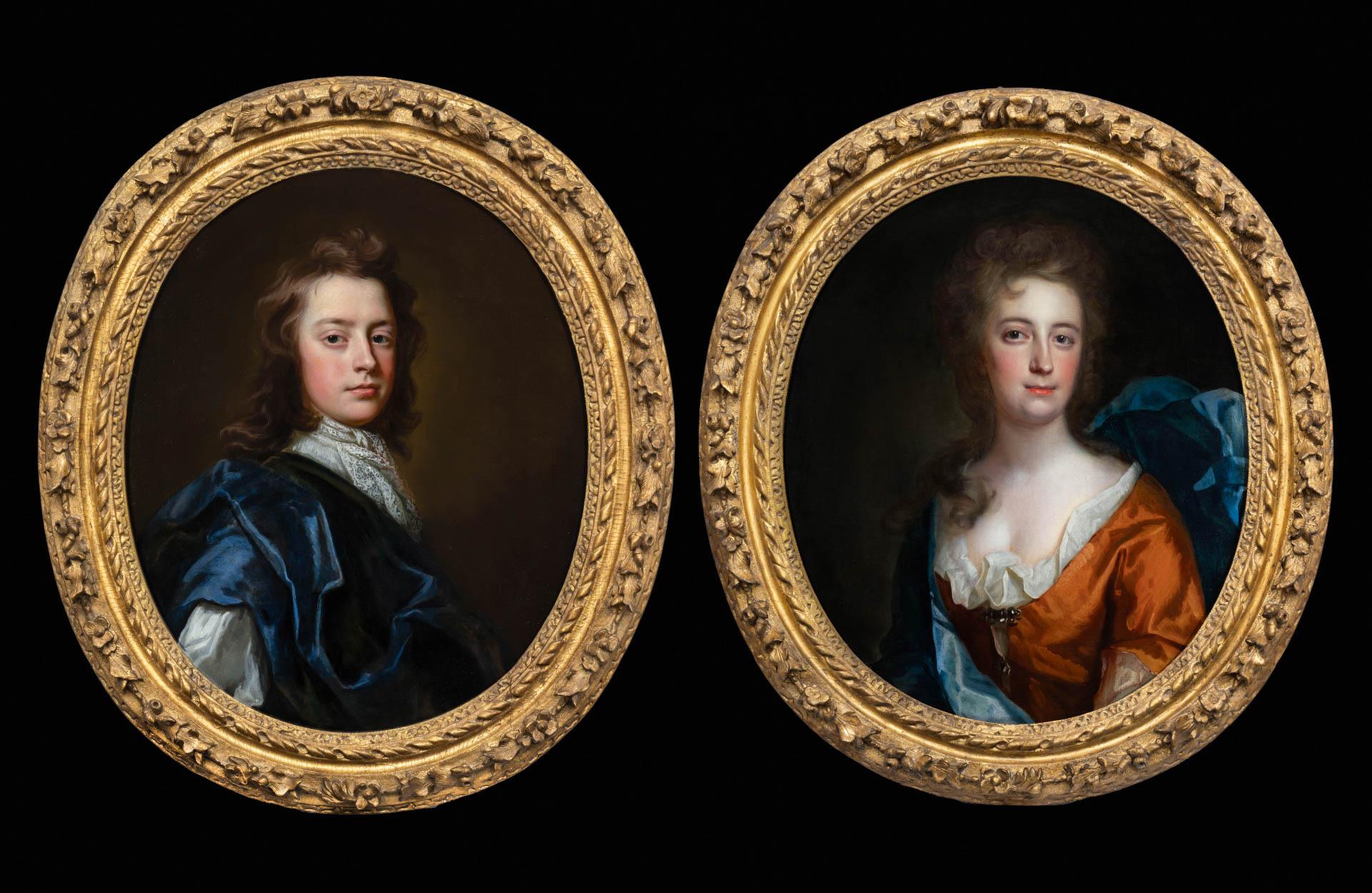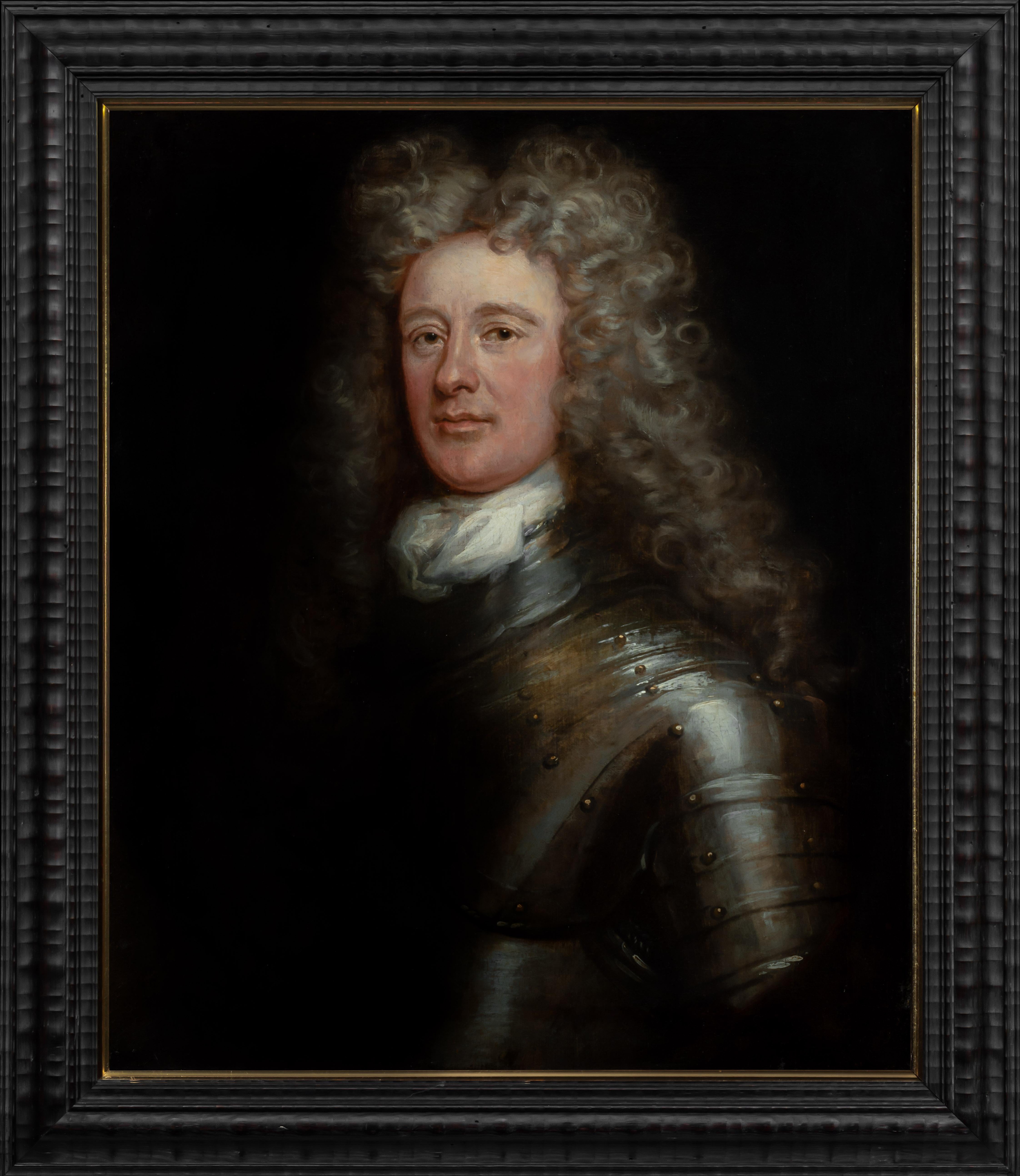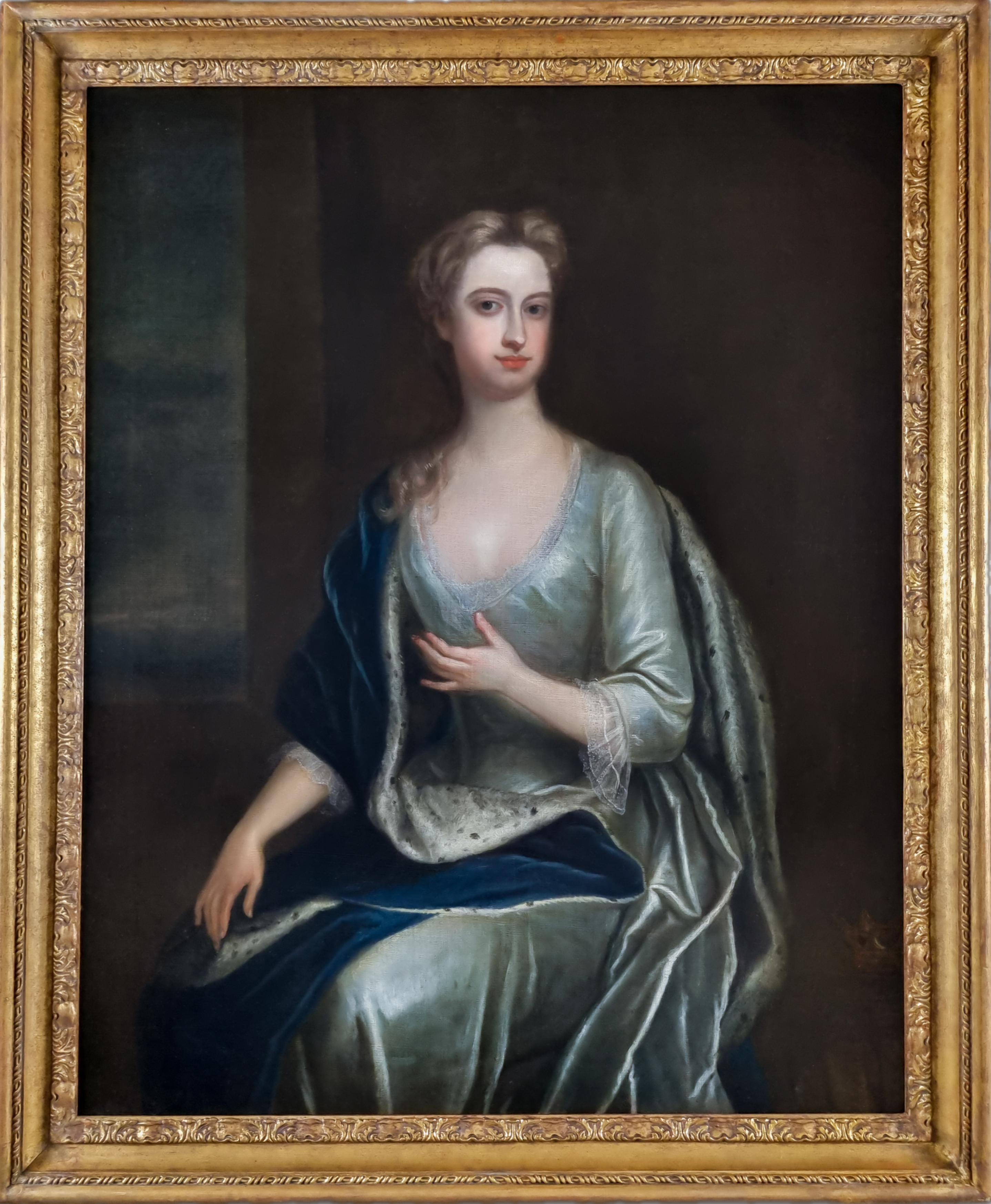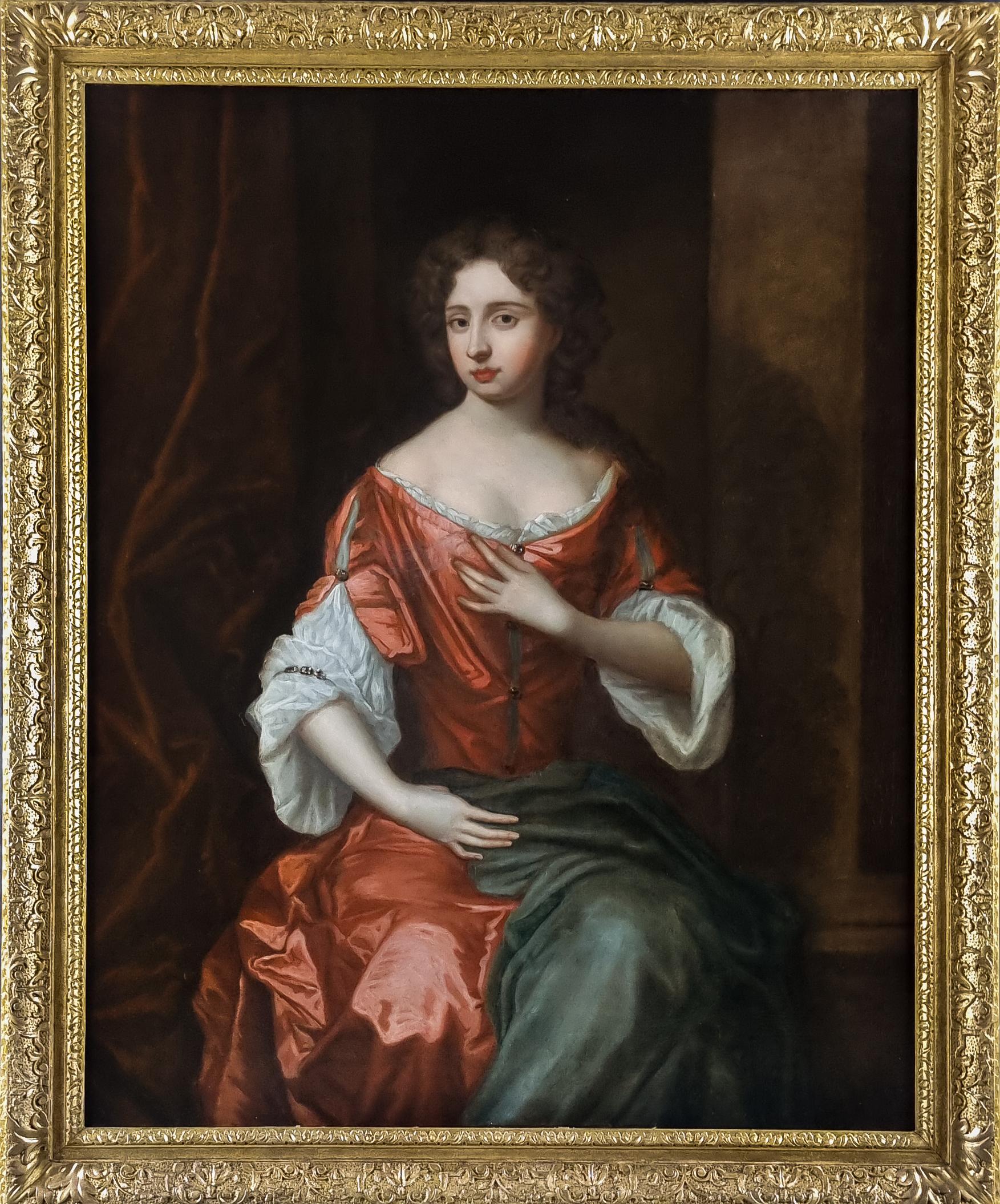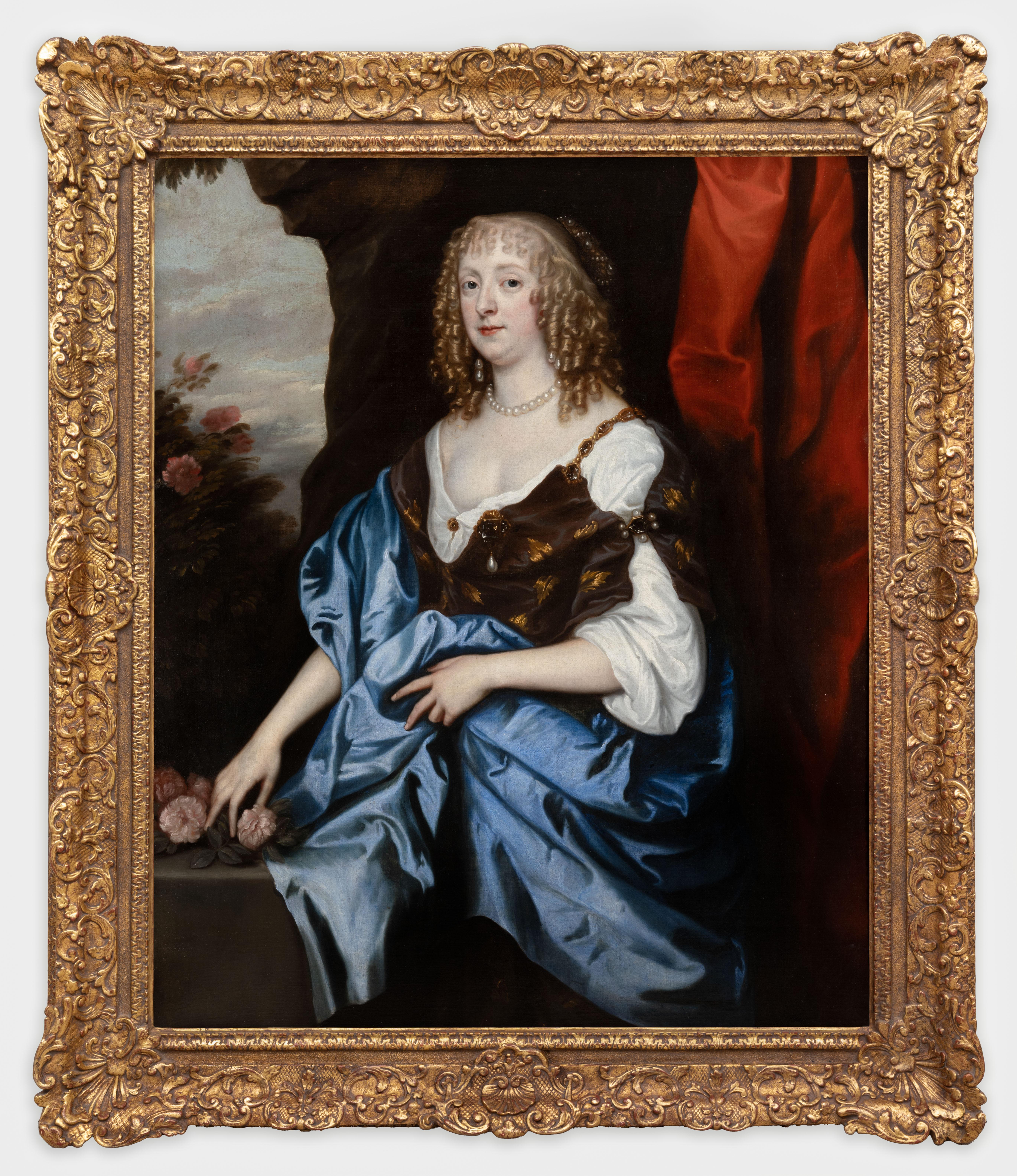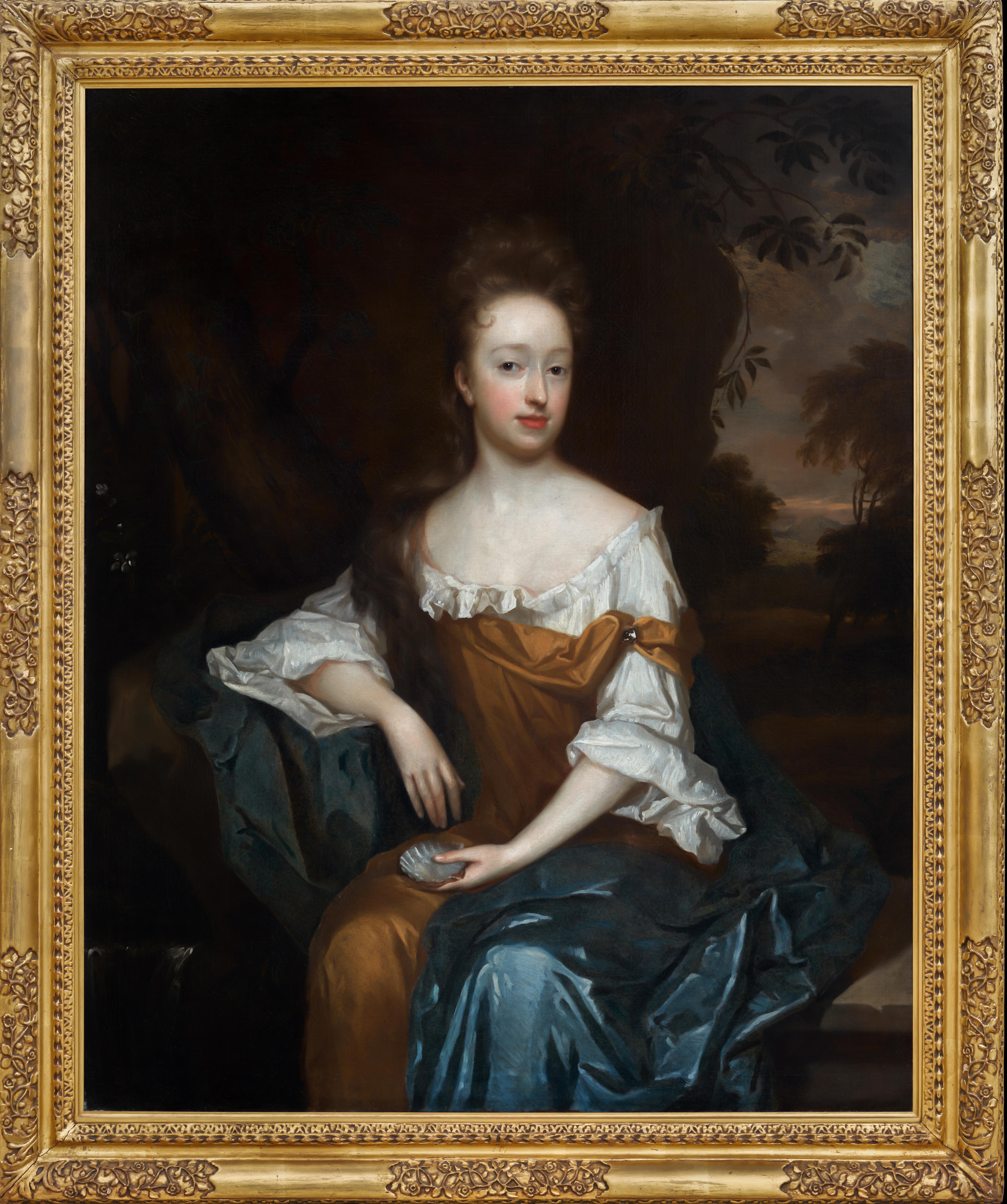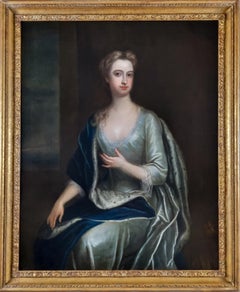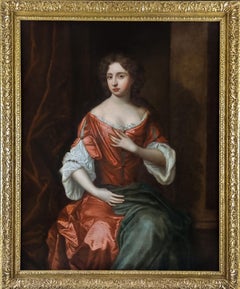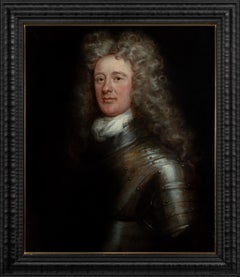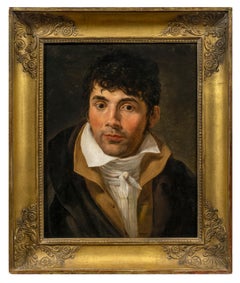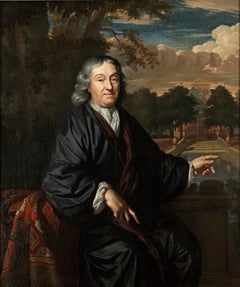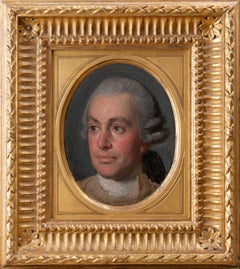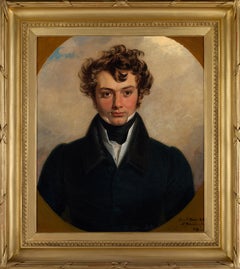Artículos similares a Portrait of William of Orange, later William III, in Armour, Peter Lely Painting
¿Quieres más imágenes o vídeos?
Solicita imágenes o vídeos adicionales al vendedor
1 de 11
Portrait of William of Orange, later William III, in Armour, Peter Lely Paintingcirca 1680
circa 1680
Acerca del artículo
This exquisite portrait, presented by Titan Fine Art, depicts King William III, when he was Prince of Orange. The military-minded William III is portrayed as the archetypal commander – serious and authoritative. He wears full armour of highly polished steel and holds a baton of command, and in the left margin is a helmet with a large scarlet plume and in the distance is a military engagement. Many portraits of William III show him in armour, a symbol of his kingship, often reflecting the style set by the Italian and Flemish artists Titian and Rubens in their depictions of kings and rulers ready for battle.
Sir Peter Lely settled in England in c.1641, becoming the leading portrait painter, with many assistants and pupils in his studio practice. At the Restoration he was appointed Principle Painter by King Charles II. This painting is based on a type by Lely of c.1674, an earlier variant of which can be found in the Royal Collection, and this particular composition was favoured by Lely for his royal and ducal portraits. Five other versions are known to exist, not including one commissioned by James II from Lely’s pupil, Willem Wissing, in 1685. The portraits became very popular and the studios met this demand by producing many duplications and versions, thus adorning the walls of many English great halls. Our portrait was most likely painted around 1680.
Prince William of Orange was highly important in the politics of Europe. He had been Captain General of the Dutch United Provinces in their war against the armies of Louis XIV and was an important figure to the Protestant cause in England. In 1677, William married his cousin Mary, who was the eldest daughter of James, Duke of York, brother of Charles II and heir to the English throne. James and his wife were Catholic and Protestants worried that any son born to the couple would eventually become a Catholic king. The marriage of William and Mary had been encouraged by Charles II, Mary’s uncle and James’s brother, as it raised the prospect of a Protestant heir to the throne.
Charles II died in 1685 and James became King James II and many in Protestant England were deeply suspicious of the new Catholic monarch. When his wife gave birth to a son it confirmed their worst fears of a Catholic succession. This meant that Mary was no longer next in line to the throne. Alarmed by the situation, a group of James's Protestant opponents secretly invited William to invade England and oust his father-in-law.
William’s mighty invasion force landed in Devon in November 1688. Many Englishmen supported William and, after some prominent English nobles defected to the invader, James II chose not to fight. He was subsequently captured and then allowed to escape to exile in France. Early in 1689, the English Parliament formally offered William and Mary the throne as joint monarchs. The new monarchs could not rule with the same power as previous monarchs enjoyed. They accepted Parliament’s ‘Declaration of Rights’ (later called ‘Bill of Rights) which restricted the king’s power and marked an important transition towards the system of parliamentary rule that exists to this day. Later that year James landed in Ireland with French troops supplied by William of Orange’s sworn enemy, Louis XIV. In response William raised a huge invasion force, the largest Ireland had ever seen, and he decisively defeated James at the Battle of the Boyne. In Europe, William was successful in his lifelong struggle to contain the military ambitions of Louis XIV, the Catholic king of France.
Mary II died of smallpox on 28 December 1694, aged 32, leaving William heart-broken to rule alone. Despite his conversion to Anglicanism, William's popularity in England plummeted during his reign as a sole monarch and in 1702 William died of pneumonia and was buried in Westminster Abbey alongside his wife. His sister-in-law and cousin, Anne, became queen regnant of England, Scotland and Ireland.
Measurements: Height 124cm, Width 149cm framed (Height 48.75”, Width 58.75” framed)
- Año de creación:circa 1680
- Dimensiones:Altura: 124 cm (48,82 in)Anchura: 149 cm (58,67 in)Profundidad: 8 cm (3,15 in)
- Medio:
- Movimiento y estilo:
- Círculo de:Sir Peter Lely (1618 - 1680, Holandés)
- Época:
- Estado:The condition is very good and can be hung and enjoyed immediately. The painting has passed a strict condition assessment by a professional conservator prior to going on sale.
- Ubicación de la galería:London, GB
- Número de referencia:1stDibs: LU1199116438242
Sobre el vendedor
5,0
Vendedor Oro
Vendedores premium que mantienen una calificación de +4,3 y tiempos de respuesta de 24 horas
Establecido en 1998
Vendedor de 1stDibs desde 2019
43 ventas en 1stDibs
Tiempo de respuesta usual: 1 hora
- EnvíoRecuperando presupuesto…Envío desde: London, Reino Unido
- Política de devolución
Partes de esta página se han traducido automáticamente. 1stDibs no puede garantizar la exactitud de las traducciones. El inglés es el idioma predeterminado de este sitio web.
Garantía de autenticidad
En el improbable caso de que haya algún problema con la autenticidad de un artículo, ponte en contacto con nosotros en un plazo de 1 año para recibir un reembolso total. DetallesGarantía de devolución de dinero
Si tu artículo no es como se describe, sufre daños durante el transporte o no llega, ponte en contacto con nosotros en un plazo de 7 días para recibir un reembolso total. DetallesCancelación dentro de las 24 horas
Tienes un período de gracia de 24 horas para reconsiderar tu compra, sin preguntas.Vendedores profesionales aprobados
Nuestros vendedores de primera clase deben cumplir estrictos estándares de servicio para mantener la integridad de nuestros anuncios.Garantía de igualación de precios
Si encuentras que un vendedor publicó el mismo artículo por un precio menor en otro lado, igualaremos ese precio.Entrega global de confianza
Nuestra red de transporte de primera ofrece opciones de envío especializado en todo el mundo, que incluye envío personalizado.Más de este vendedor
Ver todoRetrato de Frances, Vizcondesa Scudamore con vestido plateado y capa azul
Por Charles Jervas
Retrato de Frances, vizcondesa Scudamore con vestido plateado y manto azul c.1709-1719
Por Charles Jervas (1675-1739)
Este elegante y gracioso retrato, presentado por Titan Fine Ar...
Categoría
siglo XVIII, Antiguos maestros, Pinturas de retratos
Materiales
Lienzo, Óleo
Retrato de una dama vestida de rojo en el porche c.1680, procedencia aristocrática inglesa
Presentado por Titan Fine Art, este cuadro formaba parte de una colección histórica de una familia aristocrática inglesa, Lord y Lady Sandys, en su magnífica casa familiar barroca y ...
Categoría
siglo XVII, Antiguos maestros, Pinturas de retratos
Materiales
Lienzo, Óleo
Retrato de caballero azul y capa, Retrato de dama, marcos dorados finamente tallados
Retrato de caballero con capa azul y Retrato de dama vestida de russet c.1697
Thomas Murray (1663-1735)
Estos fascinantes retratos son ejemplos exquisitos del retrato en Inglaterra ...
Categoría
siglo XVII, Antiguos maestros, Pinturas de retratos
Materiales
Óleo, Lienzo
Retrato de un caballero, David Erskine, XIII Laird de Dun, con armadura c.1700
El caballero de este exquisito retrato al óleo sobre lienzo, presentado por Titan Fine Art, se muestra con la grandilocuencia característica de la pintura de la English School. Se l...
Categoría
siglo XVII, Antiguos maestros, Pinturas de retratos
Materiales
Óleo, Lienzo
Retrato de Catherine Murray, Condesa de Dysart, Rosas, Marco dorado, Van Dyke
Por Anthony van Dyck
Esta exquisita obra Grand Manner, presentada por Titan Fine Art, es un evocador ejemplo del tipo de retrato en boga durante los siglos XVII y XVIII. Bellamente compuesta, la modelo ...
Categoría
siglo XVII, Antiguos maestros, Pinturas de retratos
Materiales
Lienzo, Óleo
Retrato de una dama junto a un arroyo del bosque sosteniendo una concha c.1690; Óleo sobre lienzo
Por Harman Verelst
Este elegante retrato, presentado por Titan Fine Art, representa a una bella joven sentada en una zona boscosa, apoyando un brazo en una roca, ante un paisaje y un cálido cielo noctu...
Categoría
siglo XVII, Antiguos maestros, Pinturas de retratos
Materiales
Lienzo, Óleo
También te puede gustar
Retrato de un caballero
Círculo de Jacques-Louis David
(Francés, siglo XVIII)
Procedencia:
Colección privada, Buenos Aires
Expuesto:
"El Arte de Coleccionar", Instituto de Arte de Flint, Flint, Michigan...
Categoría
siglo XVIII, Antiguos maestros, Pinturas
Materiales
Lienzo, Óleo
45.000 US$
Retrato masculino y femenino, ambos con kimono de seda, posiblemente comerciantes textiles
Por Christoffel Lubieniecki
CHRISTOFFEL LUBIENIECKI (1659-1729)
Pareja de retratos de un caballero y una dama, ambos con kimono de seda, ante una casa de campo (hacia 1680)
Indistintamente firmado "C......."...
Categoría
Década de 1680, Antiguos maestros, Pinturas de retratos
Materiales
Lienzo, Óleo
Retrato del siglo XVIII del pintor Nathaniel Dance
Colecciones:
Robert Gallon (1845-1925);
Colección privada, Reino Unido.
Óleo sobre lienzo colocado sobre tabla
Dimensiones enmarcado: 11,5 x 10 pulgadas
Este atractivo retrato in...
Categoría
siglo XVIII, Antiguos maestros, Pinturas de retratos
Materiales
Lienzo, Óleo, Panel de madera
Retrato del siglo XIX pintado en San Petersburgo en 1819
Firmado, inscrito y fechado, abajo a la derecha:
Geo Dawe RA San Petersburgo 1819", también firmado
con las iniciales, en la parte inferior central: "G D RA"; y firmado e inscrito e...
Categoría
siglo XIX, Antiguos maestros, Pinturas de retratos
Materiales
Óleo, Lienzo
Siglo XVI Por el Círculo de Giovan Battista Moroni Retrato de mujer Óleo sobre lienzo
Giovan Battista Moroni (círculo de) (Albino, Italia, 1520 - 1580 ca.)
Título: Retrato de mujer
Técnica: Óleo sobre lienzo
Dimensiones: sin marco 46 x 40 cm - con marco 55,5 x 50,5 c...
Categoría
siglo XVI, Antiguos maestros, Pinturas de retratos
Materiales
Lienzo, Lienzo de algodón, Óleo
Siglo XVIII por Pietro Bardellino Cuadro María Magdalena Óleo sobre lienzo
Por Pietro Bardellino
Pietro Bardellino (Nápoles, Italia, 1731 - 1806)
Título María Magdalena
Técnica: Óleo sobre lienzo
Dimensiones: sin marco 75 x 60 cm - con marco 97 x 82 cm
Marco de madera tallada co...
Categoría
mediados del siglo XVIII, Antiguos maestros, Pinturas de retratos
Materiales
Lienzo, Óleo
